How to Grow Herbs in Straw Bales
If you love fresh herbs but have no room for a garden, this article on how to grow herbs in straw bales is the solution you need. Get the step by step help on prepping, how to plant, tend to, harvest, and so much more.
Gardening 101 should include herbs, and sometimes you need another option so you can enjoy the foods you love. This is my favorite way to garden, and I cannot wait to share it with you.
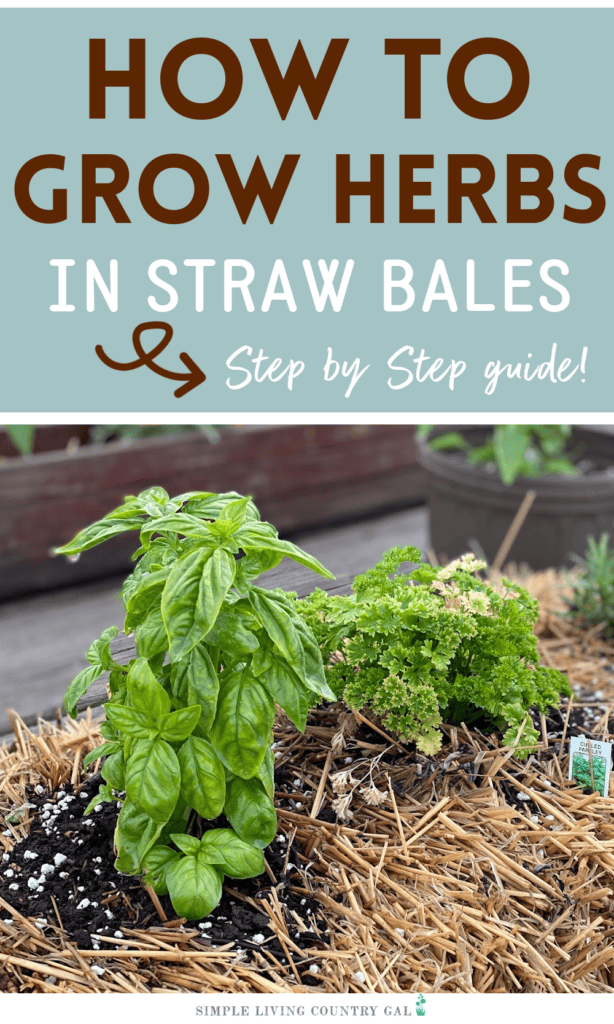
If you love fresh herbs but lack the space or time for a traditional garden, you will want to try straw bale gardening.
This unique growing method involves planting herbs (and other crops) directly into bales of straw. Not only is it an easy and affordable way to grow herbs, but it’s also an option that utilizes the space you have, conserves water and keeps your backyard intact.
I will walk you through how to grow herbs in straw bales, from selecting the best location and prepping them for planting to nurturing your plants and harvesting a bountiful crop.
What is straw bale gardening?
Straw bale gardening is a growing method that involves planting crops directly into bales of straw. It is an easy and affordable way to grow herbs, vegetables, and other plants, especially for those with limited space or poor soil quality.
The straw bales act as a container providing ideal conditions for plants to grow. The compacted straw inside the bales also composts over time, providing additional nutrients to the plants.
At the end of the growing season, bales can be composted down, leaving little mess for cleanup.
Straw bale gardening is a growing option that is quickly gaining popularity all over.
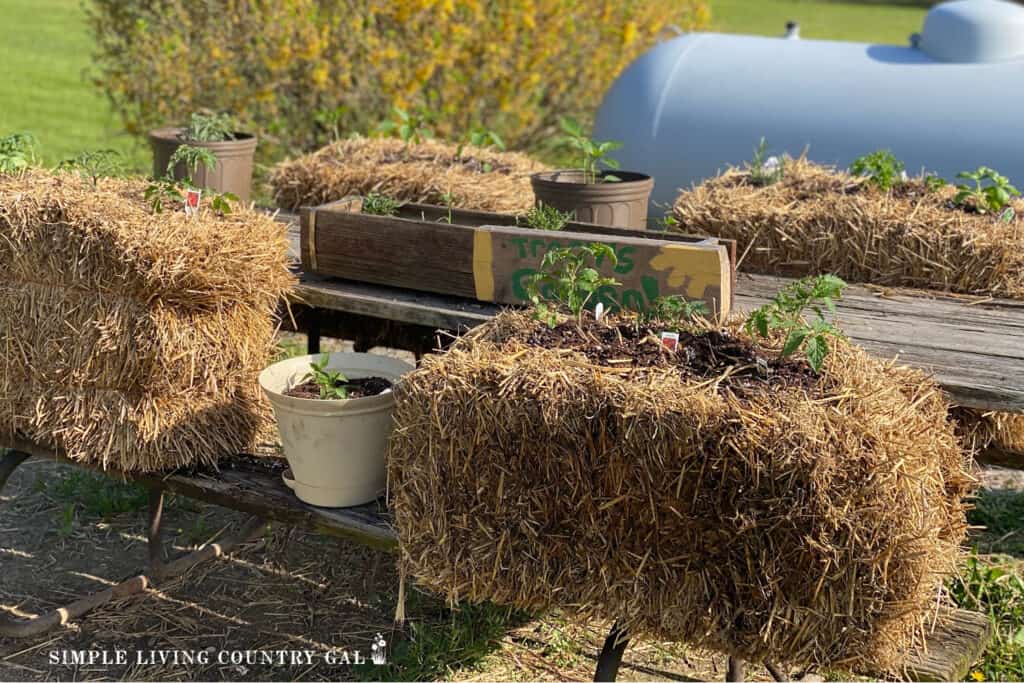
What are the benefits of growing herbs in a straw bale garden?
Growing herbs in a straw bale garden has several benefits.
• First, it is an easy and affordable way to create a garden, especially if you have limited space or poor soil quality.
• Growing herbs in straw bales also provides better drainage, which can help prevent root rot in plants.
• My favorite part is that straw bales are also weed-free. That means there is no need for weeding.
• As the straw bale decomposes over time, it provides additional nutrients to the plants.
• Lastly, straw bale gardens are raised off the ground, making them easier to access for people with mobility issues.
How to Grow Herbs in Straw Bales
As with anything new, there can be quite a bit of overwhelm your first time gardening in straw bales. To help, I have broken things down into small steps. Start at the top and work your way down and watch your herb straw bale garden take shape!
Step 1: Select Your Location
When choosing a location for your straw bale garden, there are a few important factors to consider.
Sunlight: Look for a location that receives at least six hours of direct sunlight each day. Most herbs need full sun to thrive. Be sure there are no trees or large bushes that can block out the sun needed during the day.
Water: Make sure the location is easily accessible to water, as straw bales need to be watered frequently. If you do not have space near a water source, you can fill empty, cleaned milk jugs as I did one year.
Soil: The beauty of straw bale gardening is that you don’t need good soil to start.
Space: Choose a location with enough space for the number of straw bales you want to plant. For my setup, I like to have my bales in an H, U, or L pattern. This gives me access to all sides so I can water and tend to them as needed.
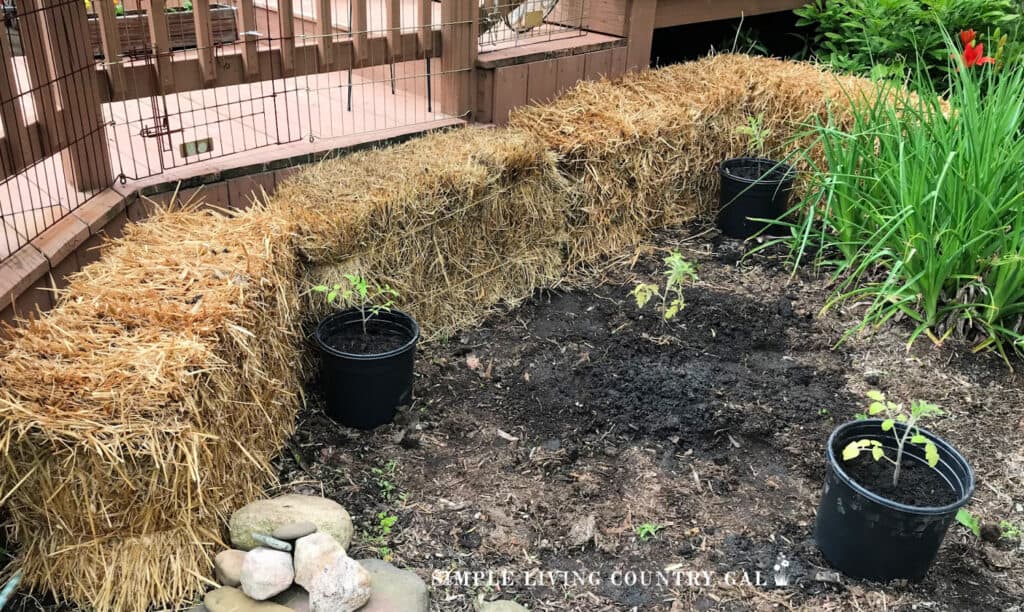
Accessibility: Consider your own needs and abilities when choosing a location. Make sure it is easily accessible to you and anyone else who will be tending the garden. If you have physical limitations, you can put your bales up higher where it is easier to reach. Consider a bench or table for this option.
What are the supplies you need for a straw bale garden?
To start an herb straw bale garden, you will need a few supplies:
Straw bales: Look for local straw bales in your area. You can reach out to neighboring farmers, the local feed store, or your county extension office.
Be sure you are using STRAW bales and not HAY bales. If you are not sure of the difference, I encourage you to read my article: The Difference Between Hay and Straw Bales
Fertilizers: Organic fertilizers such as blood meal, bone meal, or a balanced blend of NPK fertilizers are great options if needed.
Herb plants/seeds: Choose which herbs you want to grow and ensure the herb varieties are suitable for the soil and climate in your area.
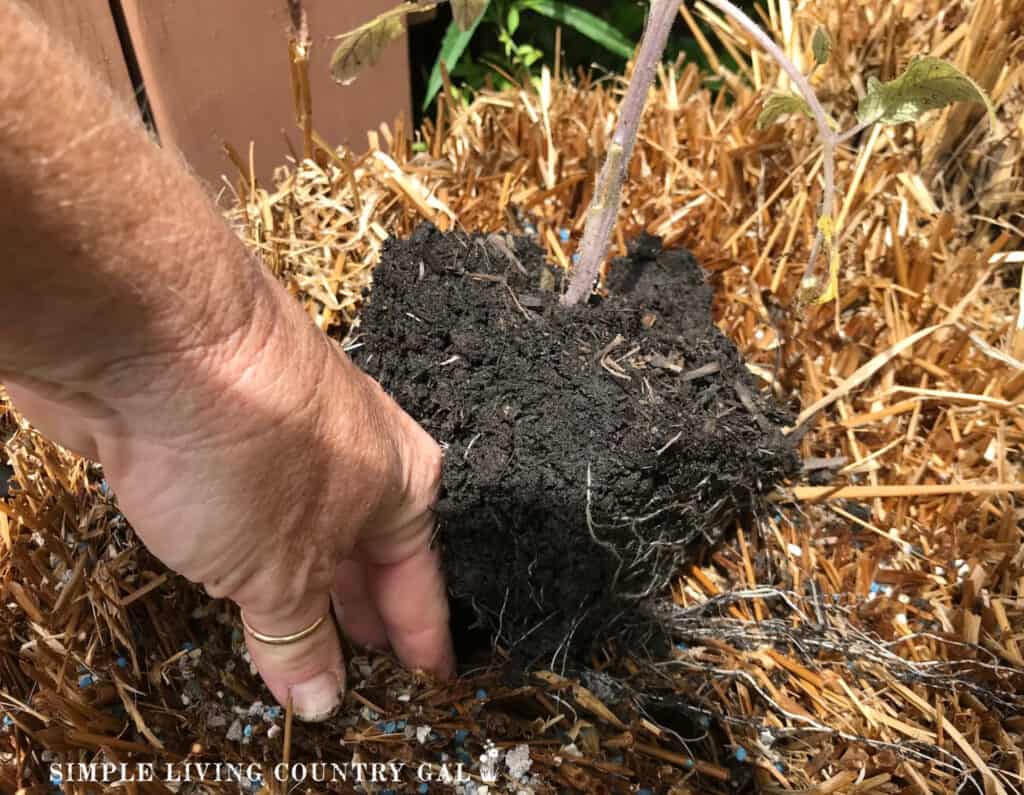
Water source: You’ll need a convenient water source to make watering easier and more efficient. A good quality garden hose and spray nozzle that gives a steady, gentle flow are good tools to have on hand.
Tools: Stock up your gardening tool kit with these basic gardening tools:
Once you have gathered all the necessary supplies, you’ll be ready to start prepping your bales for planting.
Step 2: Prepare the Straw Bales
Preparing bales for gardening is called conditioning. Conditioning straw bales is an essential step in preparing them for a herb garden.
Supplies needed:
- Fertilizer – look for a high-nitrogen option.
>> Avoid slow-release options or fertilizers with herbicides or crabgrass preventers.
- Bone/fish meal
- Wood ash
- Compost thermometer
- Straw bales
How to Prep Bales:
- Day one: Sprinkle 2 cups of fertilizer over each bale and water thoroughly.
- Day two: Water each bale.
- Day three: Sprinkle 2 cups of fertilizer over each bale and water thoroughly.
- Day four: Water each bale.
- Day five: Sprinkle 2 cups of fertilizer over each bale and water thoroughly.
- Day 6: Water each bale.
- Days 7-13: Sprinkle 1/2 cup of fertilizer over each bale every day followed by a good watering.
- Day 14: Add 3 cups of bone/fish meal plus wood ash if you have any on hand.
After day 14, your straw bales are ready for planting.
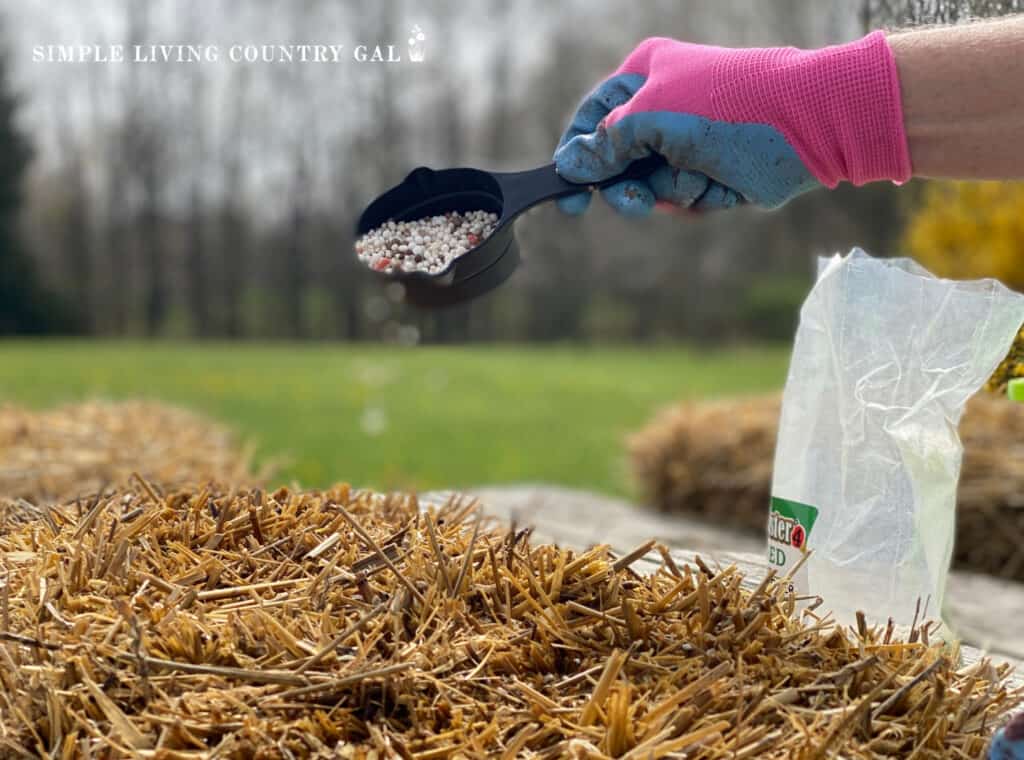
Step 3: Plant Your Herbs
There are a few things to remember when growing herbs in straw bales. First and foremost, you need to choose the right type of herb for your garden; some herbs thrive better than others in these conditions. Popular choices include oregano, basil, thyme, sage, rosemary, and mint.
Other herbs like parsley and chives are also suitable for straw bale gardening.
Planting Your Herbs
Once you’ve chosen the right type of herb, you can start planting. Be sure to partner up each herb with friendly herbs, so they support each other and grow more successfully. This is called companion planting, and it is a great way to improve the quality of your herbs.
If you’ve chosen seeds, add some potting soil to the top of the bill and plant as directed on the seed packet. Cover with soil, gently part down, and water.
If you’ve chosen seedlings, make a hole in the top of the bale using your hands or a trowel. Add a small amount of potting soil to the hole, giving the roots a good area to grow in. Next, gently remove the seedlings from their pots using your hands to break up the roots. Put the seedling into the hole, adding more soil to hold the plant in place. Refer to the directions of the seedling for spacing and depth.
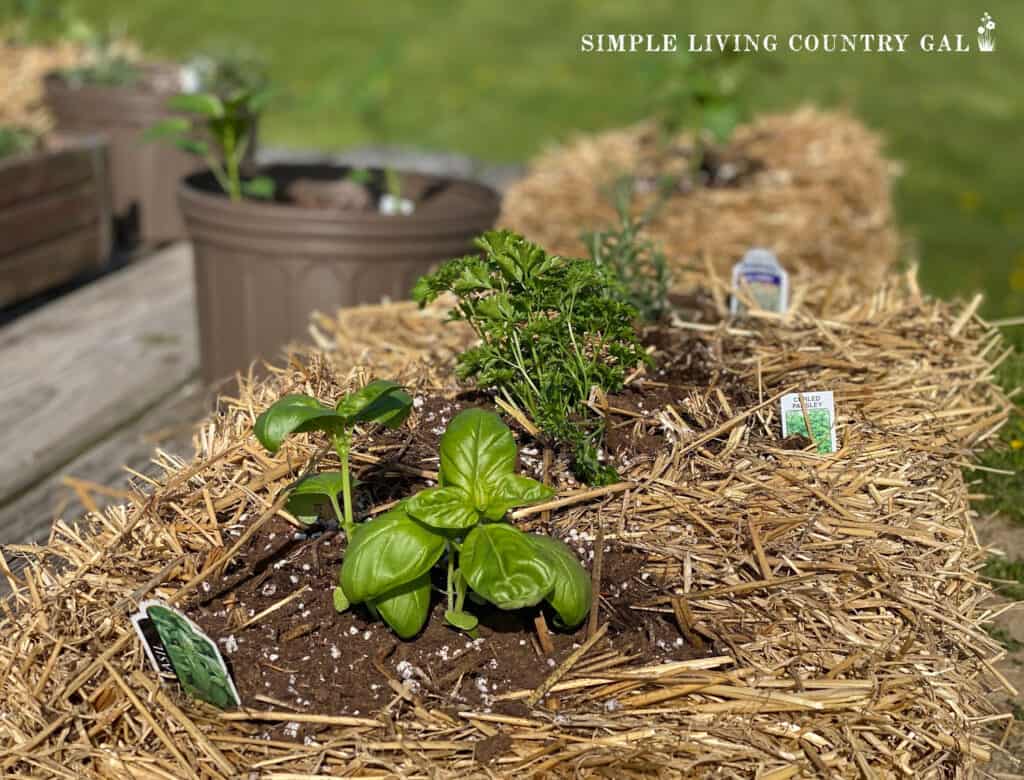
Watering Herbs
One important thing to remember when gardening in straw bales is there is no way to contain the water inside the bale. This means you will need to water more frequently than you would with a traditional backyard garden.
I like to water a few times a day, depending on the temperature and the dryness of the day. Herbs need both water and nutrients to grow properly. Starting out, you may want to set a reminder on your phone.
How do I know if my herbs are overwatered?
Overwatered herbs will be stunted, giving you a lackluster crop. If you see your plant’s leaves are yellow or have fallen off, you may be overwatering your plants.
A few more signs to watch for are:
- Yellow or dark-colored leaves.
- Fuzzy mildew on the plant or its leaves.
- Wilted leaves.
If you have overwatered your plant, allow it to dry out. Many times a plant can recover on its own, and only time will tell you if you caught the issue in time.
Fertilizing Herbs
When it comes to feeding your herbs, you can use compost or manure tea to give them an extra boost of nutrition. You can also feed them diluted fish emulsion fertilizer once per month for maximum growth.
Step 4: Set Up a Maintenance Routine
Using a routine will help to ensure your bales are healthy for the entire growing season.
Moisture Levels
Maintaining the soil moisture level is crucial for the success of your herb straw bale garden. Make it a habit to check the moisture level of the bales daily. Stick your finger into the bale, about two inches deep, and feel the moisture level.
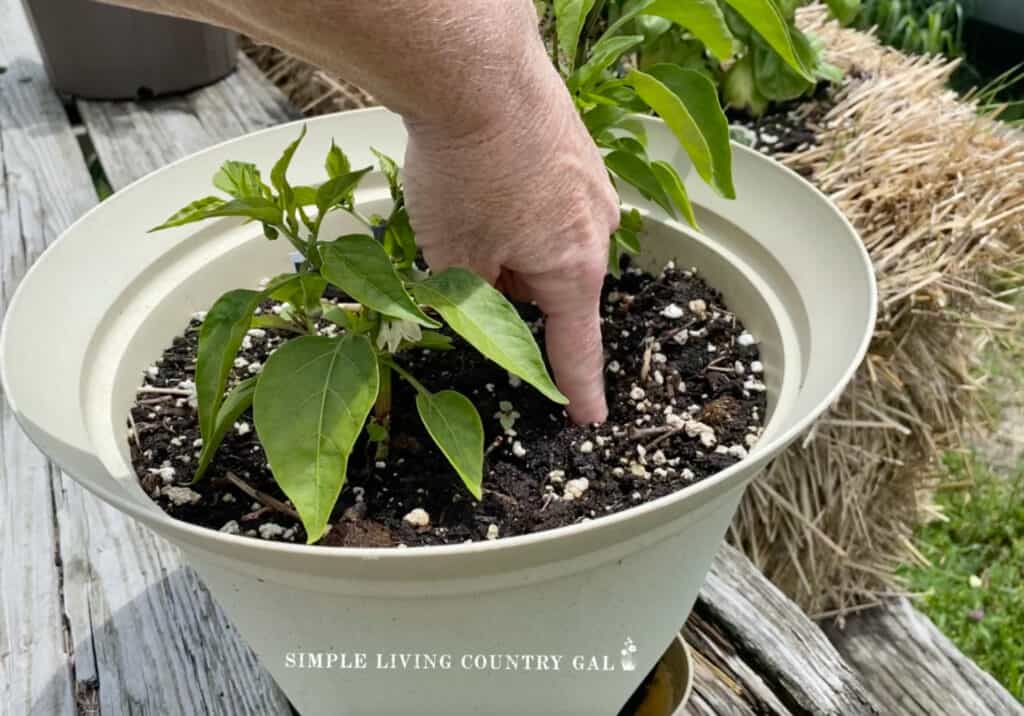
Straw bale gardens dry out quickly, so you must water regularly. I like to water in the mornings and then again in the afternoons. This routine is usually best to allow the bales to retain the water.
Watch for Pests and Diseases
Inspecting your herb straw bale garden regularly for pests and diseases is integral to maintaining a healthy and productive garden.
• Watch for signs of pests by checking your herbs’ leaves, stems, and fruits for damage, discoloration, or bite marks, which could indicate an insect infestation.
• Once you’ve identified signs of damage, research the possible pests causing the issue.
• For a safer, more organic approach, use diatomaceous earth, or spray your herbs with a mixture of water and dish soap.
• Look for any signs of wilting, rot, or discoloration, which could indicate disease. Remove any plants that are infected to prevent spreading to other healthy plants.
By staying vigilant and taking proactive steps to prevent and address pests and diseases, you can ensure that your herb straw bale garden is always healthy and productive.
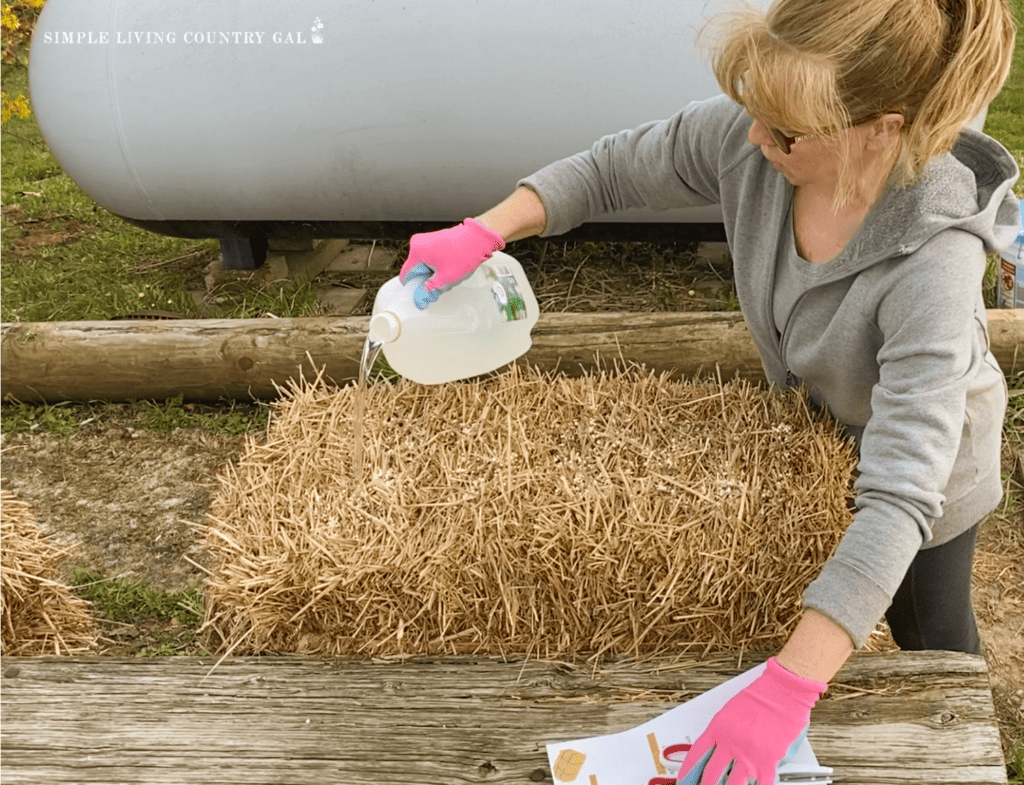
Regular Trimming of Plants
Trimming or pruning herbs in your straw bale garden is important to keep them healthy and productive. You’ll need a pair of clean, sharp pruning shears to trim your herbs. It is important to clean your pruning shears before and after you use them to prevent the spread of disease.
• Start with dead or wilted leaves trimming away any affected leaves. This will help to keep the plant healthy and prevent the spread of disease.
• Trim your herb plants to maintain a compact shape and promote growth. Cut a few inches above where you would like the plant to grow.
• Some herbs, like basil, produce flowers that can signal the end of the growing season. When you see flowers forming, trim them to encourage the plant to continue producing leaves and delay flowering.
• Be careful not to trim your herbs too much, as this can shock the plant and slow its growth.
• After you’ve finished trimming, dispose of the trimmings and clean up the area around the plant to discourage pests and disease.
Harvesting Herbs Grown in Straw Bales
Knowing when to harvest your herbs is essential for getting the best flavor and quality from your straw bale garden.
• Different herbs have different ideal harvesting times because of their growth patterns. For example, basil should be harvested at around 6 inches tall or when it starts blooming. While herbs such as thyme or oregano can be harvested most of the season.
• One of the best ways to know when to harvest is simply by their smell. Sniff the leaves of your herbs; if they have a strong aroma, they are ready to harvest.
• Keep an eye out for the first set of leaves on the stem as they mature. The first set often pulls away from the stem; the area underneath should form a rounded leaf structure indicating that it is ready for harvest.
• When harvesting, cut leaves at the base of their stem and do not remove the full plant at once. This allows the herb to continue growing and producing more leaves.
• The best time to harvest herbs is in the morning after the dew has dried or in the late afternoon. Do not harvest when leaves are wet, as they are more susceptible to damage.
Closing up Bales at the End of Your Growing Season
After using the straw bales to grow your herb garden, you have a few options for what to do with them next.
• The straw bales can be added to a compost pile or used as winter covering mulch in your garden or over any garlic beds. Over time, they will break down and add nutrients to the soil.
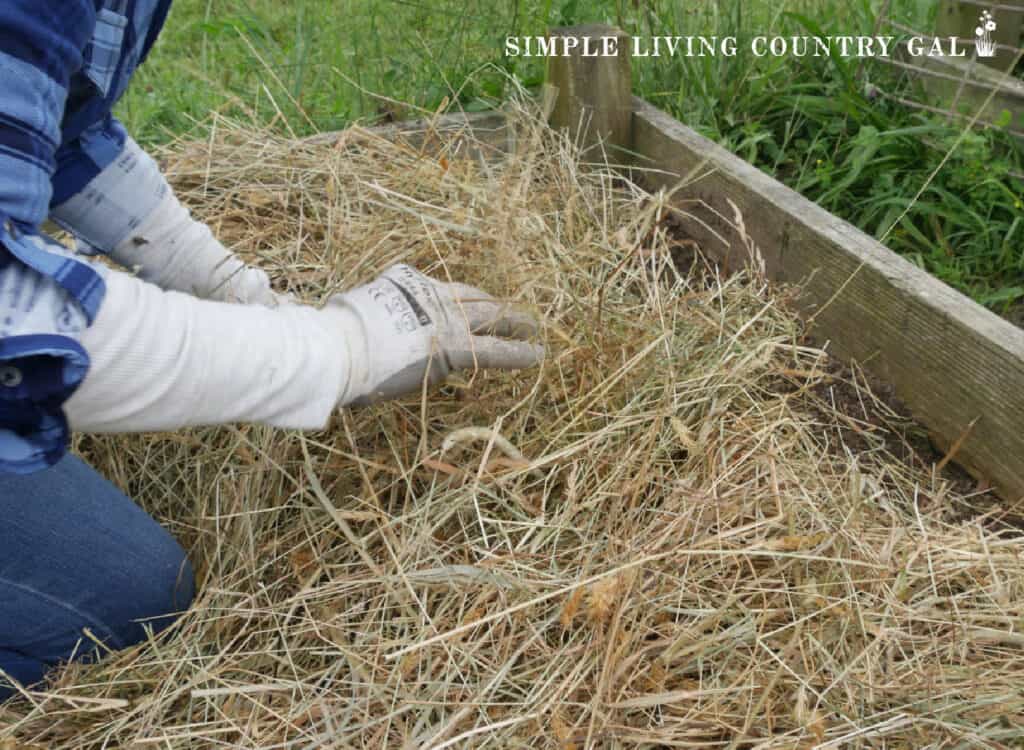
• If the bales are too damaged or infested with pests, they should be discarded. Check with your local waste management facility to see if they accept straw bales for pickup.
By composting or disposing of the bales properly, you are maintaining the sustainability aspect of the straw bale gardening method and continuing its benefits to our environment.
Creating an herb straw bale garden is a fun and unique way on how to start a backyard garden that fits your space and time of life. With the right supplies, some prep work, and regular maintenance, you can have your very own herb garden in no time.
More Herb Growing Resources:
How to Grow Herbs in Straw Bales
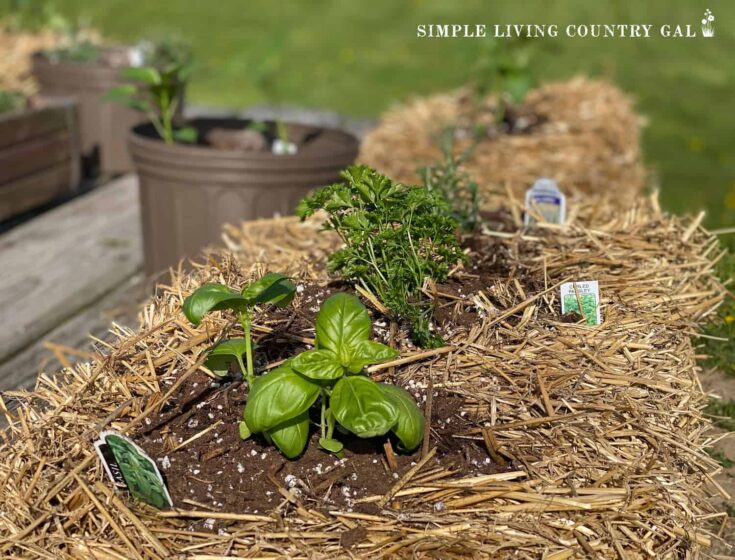
If you love fresh herbs but have no room for a garden, this article on how to grow herbs in straw bales is the solution you need. Get the step by step help on prepping, how to plant, tend to, harvest, and so much more.
Materials
- Herb Seeds
- Water
- Straw Bales
- Fertilizer or compost (optional)
- Lime (optional)
Tools
- Gardening Gloves
- Hand Trowel
- Pruning Shears
- Compost Thermometer
Instructions
- Prepare the straw bales in a location with at least 6 hours of sun per day.
- Condition the straw bales:
- Day one: Sprinkle 2 cups of fertilizer over each bale and water thoroughly.
- Day two: Water each bale.
- Day three: Sprinkle 2 cups of fertilizer over each bale and water thoroughly.
- Day four: Water each bale.
- Day five: Sprinkle 2 cups of fertilizer over each bale and water thoroughly.
- Day 6: Water each bale.
- Days 7-13: Sprinkle 1/2 cup of fertilizer over each bale every day followed by a good watering.
- Day 14: Add 3 cups of bone/fish meal plus wood ash if you have any on hand.
- Plant herbs in your conditioned straw bales. If using seeds, add some potting soil to the top of the bill and plant as directed on your seed packet. If using seedlings, make a hole in the top of the bale using your hands or a trowel.
- Water a few times a day more if hot and dry day.
- Check moisture levels daily by sticking a finger into the bale about two inches deep, and feel the moisture level.
- Trim your herbs regularly to keep them healthy and productive.
- Harvest your herbs just before flowering.
- Store your herbs based on expected use time. Herbs can be stored fresh, dried, or frozen.
Notes
- Do not harvest more than 1/3 of the stem at a time for woody herbs (such as rosemary) as it will kill the plant.
- Herbs can be pruned and harvested throughout the growing season when needed. Softer varieties can be cut back by half and still regrow and flourish. Woody types, like rosemary, should only be cut back by 1/3.
- Be careful when cutting back woody herbs not to remove the stem. Cutting all of their foliage will kill them.
- After harvest your straw bales can be added to a compost pile or used as winter covering mulch in your garden or over any garlic beds. Over time, they will break down and add nutrients to the soil.
Recommended Products
As an Amazon Associate and member of other affiliate programs, I earn from qualifying purchases.
-
COOLJOB Gardening Gloves for Women and Ladies, 6 Pairs Breathable Rubber Coated Yard Garden Gloves, Outdoor Protective Work Gloves with Grip, Medium Size Fits Most, Red & Green
-
GROWNEER 3 Packs Pruning Shears with Curved Blades Gardening Hand Pruning Snips Titanium Coated Precision Blades
-
Fiskars Ergo Gardening Hand Trowel - Ergonomic Handle Design with Hang Hole - Heavy Duty Garden Tool for Digging, Garden Edging, and Weed Removal
-
Long Stem Compost Soil Thermometer for Gardening Stainless Steel Soil Testing Thermometer Fahrenheit and Celsius 1.5" Dial Display Easily Monitor The Temperature in Compost Heaps and Soil (16'')
-
Sereniseed Certified Organic Herb Seeds (10-Pack) – Non GMO, Heirloom – Seed Starting Video - Basil, Cilantro, Oregano, Thyme, Parsley, Lavender, Chives, Sage, Dill Seeds for Indoor & Outdoor Planting
-
Jobe’s Organics 09526 Organic All Purpose Granular Fertilizer 4-4-4, 4 lb






